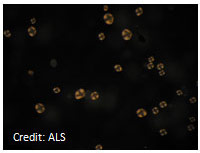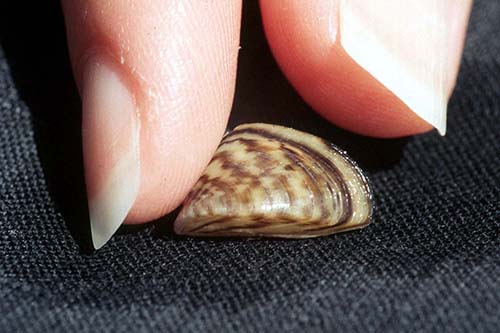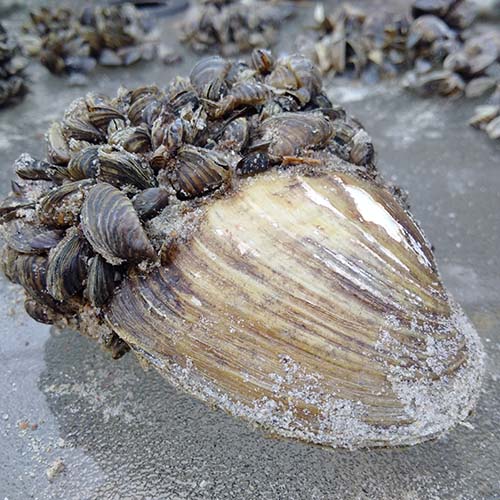
Zebra Mussels (Dreissena polymorpha)
What is a Zebra Mussel?Zebra mussels (Figure 1.) are a small, freshwater mollusk (i.e., clam-like organism), not native to North America. They are native to Europe and Asia. Why are they an issue? |
|
Zebra Mussels are a concern to Manitoba because they can:
|
|
Experience from other North American watersheds indicate that once Zebra Mussels establish - especially in larger water bodies, they are cost prohibitive to eradicate.

Figure 3. Heavy equipment removing adult Zebra Mussels from Grand Beach on Lake Winnipeg (May 2021)
Prohibition
Zebra Mussels are designated as an aquatic invasive species (AIS) in Manitoba.
In Manitoba, it is illegal to:
- possess a member of an AIS in Manitoba
- bring a member of an AIS into Manitoba or cause it to be brought into Manitoba
- deposit or release a member of an AIS in Manitoba or cause it to be deposited or released in Manitoba
- transport a member of an AIS in Manitoba
Where are Zebra Mussels found in Manitoba?
Zebra Mussels were found in:
- Lake Winnipeg in 2013
- the Manitoban portion of the Red River in 2015
- Cedar Lake in 2015 and 2021
- the lower reaches of the Nelson River in 2019
- the upper reaches of the Nelson River to Limestone in 2020
- the upper reaches of the Nelson River to Hudson Bay 2021
- Assean Lake, northwest of Split Lake in 2020
- Lake Manitoba in 2021
Distribution of Zebra Mussels in Manitoba
A Zebra Mussel distribution map of can be found here.
How did Zebra Mussels get to Manitoba?
Zebra mussels were introduced initially into North America into the Great Lakes through the discharge of contaminated cargo ship ballast water in 1986.
Since the initial introduction in the Great Lakes, human-induced movement has allowed zebra mussels to expand into water bodies in eastern Canada and the USA.
Zebra mussels were introduced into Lake Winnipeg’s south basin in 2013.
The overland movement of watercraft and water-related equipment are the main vectors to spread zebra mussels to new water bodies. It is suspected that uncleaned watercraft or water-related equipment used in Lake Winnipeg resulted in their introduction.
How to identify Zebra Mussels
Larval Zebra Mussels, called veligers are difficult to identify as they are:
- microscopic, that is, too small to see with the naked eye (Figure 4)
- free-floating and move with water currents as they are unable to swim on their own

Figure 4. Microscopic Zebra Mussel veligers found in
sample of surface water greatly magnified with a
microscope
Adult Zebra Mussels can be identified by their:
- typical dark or light bands on their shells
- small size, ranging from the size of a grain of sand growing to usually 25 mm (1 inch) long
- tuft of fine threads, called byssal threads, near the opening of the bottom of the shell which they use to firmly attach to under-water surfaces (Figure 5)

Figure 5. A smaller, adult Zebra Mussel attached to the shell of a larger,
adult Zebra Mussel where their byssal threads are visible.
Pencil in background to show scale.
How to stop the spread of Zebra Mussels in Manitoba
The most effective prevention is to stop the human-caused movement, introduction and spread of Zebra Mussels. All surface water-users play a role in preventing the introduction and spread of Zebra Mussels. Prevention is our best defense.
Moving surface water from an invaded water body can introduce larval Zebra Mussels to new water bodies.
As well, adult Zebra Mussels can seal their shells tightly and survive out of water up to 30 days depending on temperature and humidity. Spring and fall is when temperatures are lower and humidity is higher, as a result, adult Zebra Mussels can survive the longest out of water. Thus, adult Zebra Mussels can be transported long distances overland to new water bodies and survive.
The AIS Open-water Season and Winter (Ice-covered) Season checklists are step-by-step resources that can help you prevent the spread of Zebra Mussels and comply with the Manitoba government’s AIS Regulation.
Set fines for AIS offences are in effect year-round.
What should I do if you see an AIS such as Zebra Mussels?
If you see a Zebra Mussel in a water body where they are not known to exist, or where an AIS Control Zone has not been established to prevent the spread of Zebra Mussels, note the location, take pictures and report to the Manitoba government’s AIS Unit by:
- emailing AIS@gov.mb.ca
- calling 1-877-867-2470



